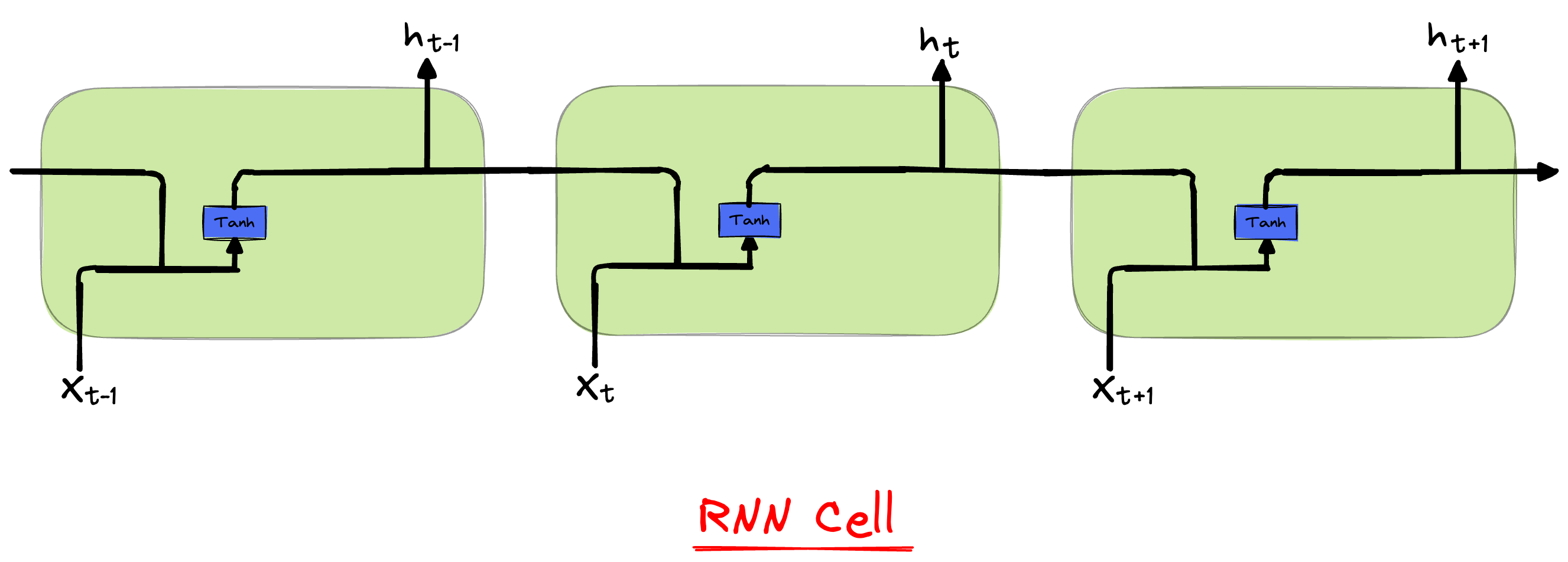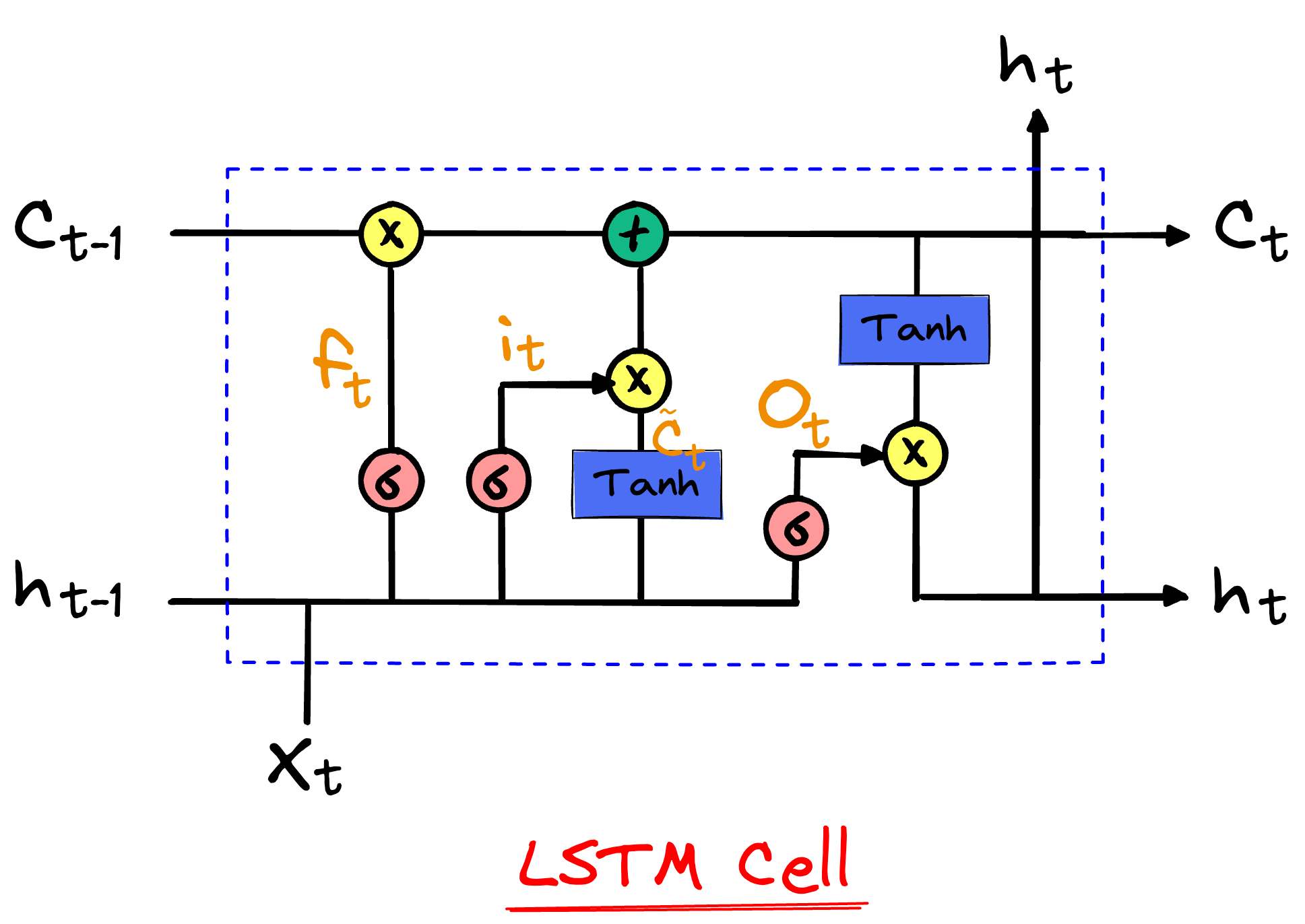由于pytorch已经将三个循环神经网络、LSTM进行了高度的封装,所以本节不再去关注网络结构的设计和复现,而是重点关注如何在自己设计的网络结构中将RNN和LSTM融入进去以实现特等的任务。
卷积神经网络是借鉴人类视觉的思想,教会计算机识别东西;从循环神经网络开始,我们的核心任务就是教会计算机理解序列数据。
人类并不是每时每刻都从头开始思考。 当我们阅读这篇文章时,会根据对前面单词的理解来理解每个单词。
循环神经网络-RNN
循环神经网络是神经网络的一种,为什么取名字要叫做循环呢?
就是因为它的神经元输出会在下一个时间步作为反馈进行输入,使整个网络具有处理序列数据的能力。
一个复杂的系统包含若干的最小单元组件,每个最小单元组件都会重复自身动作从而构成整个系统的运转,“循环”变应运而生。
普通的神经网络处理的是独立同分布数据,层与层之间就是简单的前馈链接关系,输入和输出长度是固定的。
而循环神经网络具有记忆能力,这种记忆能力体现在上层神经元的输出会作为下层神经元的输入,可以处理时序数据,而且输入输出长度不固定。
$$
h_{t}=tanh(h_{t-1}W_{h}+x_{t}W_{x}+b)
$$
$$
= tanh(h_{t-1}W_{hh}+b_{hh}+x_{t}W_{ih}+b_{ih})
$$
模型输入:input_size,hidden_size
模型输出:output_size,ht

1
2
3
4
5
6
7
8
9
10
11
12
13
14
15
16
17
18
19
20
21
22
23
24
25
26
| class RNNLayer(nn.Module):
def __init__(self,input_size, hidden_size, num_layers=1, batch_first=True):
self.hidden_size = hidden_size
self.num_layers = num_layers
self.input_size = input_size
self.bidirectional = False
super().__init__()
self.W_ih = nn.Parameter(torch.rand(self.input_size, self.hidden_size))
self.W_hh = nn.Parameter(torch.rand(self.hidden_size, self.hidden_size))
self.b_ih = nn.Parameter(torch.zeros(self.hidden_size))
self.b_hh = nn.Parameter(torch.zeros(self.hidden_size))
def forward(self,x_t,h_prev=None):
if h_prev == None:
h_prev = torch.zeros( x_t.size(0), self.hidden_size)
output = torch.tanh(torch.matmul(x_t, self.W_ih) + self.b_ih + torch.matmul(h_prev, self.W_hh) + self.b_hh)
return output,output[:,-1,:].unsqueeze(0)
|
RNN的梯度消失或爆炸问题主要体现在“循环”过程中隐藏变量的迭代计算过程中。
- 隐藏变量的参数>1: 每迭代一次都会呈现幂律型增长,经过ReLU激活后会趋向于正无穷
- 隐藏变量的参数<1: 每迭代一次都会呈现幂律型衰退,经过ReLU激活后始终等于0
长短期记忆网络-LSTM
网络的输入:隐藏变量H、记忆C、输入序列X
网络的输出:输出序列Y、隐藏变量H、新的记忆C

参数初始化:
1
2
3
4
5
6
7
8
9
10
11
12
13
14
15
16
17
18
19
20
21
22
23
24
25
26
27
28
29
30
31
32
33
34
35
36
37
38
39
40
41
42
43
44
| def init_paramaters(vocab_size,hidden_units):
std = 0.01
input_units = output_units = vocab_size
def normal(shape):
return torch.randn(size=shape) * std
forget_gate_weights = normal((input_units + hidden_units,hidden_units))
input_gate_weights = normal((input_units+hidden_units,hidden_units))
output_gate_weights = normal((input_units + hidden_units,hidden_units))
c_tilda_gate_weights = normal((input_units + hidden_units,hidden_units))
forget_gate_bias = torch.zeros((1, hidden_units))
input_gate_bias = torch.zeros((1, hidden_units))
output_gate_bias = torch.zeros((1, hidden_units))
c_tilda_gate_bias = torch.zeros((1, hidden_units))
hidden_output_weights = normal((hidden_units, output_units))
output_bias = torch.zeros((1, output_units))
paramaters = {
'fgw': forget_gate_weights,
'igw': input_gate_weights,
'ogw': output_gate_weights,
'cgw': c_tilda_gate_weights,
'fgb': forget_gate_bias,
'igb': input_gate_bias,
'ogb': output_gate_bias,
'cgb': c_tilda_gate_bias,
'how': hidden_output_weights,
'ob': output_bias
}
for para in paramaters.values():
para.requires_grad_(True)
return paramaters
|
网络结构定义:
1
2
3
4
5
6
7
8
9
10
11
12
13
14
15
| def LSTM(inputs,state,params):
[W_xi, W_hi, b_i, W_xf, W_hf, b_f, W_xo, W_ho, b_o, W_xc, W_hc, b_c,
W_hq, b_q] = params
(H,C) = state
outputs = []
for x in inputs:
I = torch.sigmoid((x @ W_xi) + (H @ W_hi) + b_i)
F = torch.sigmoid((x @ W_xf) + (H @ W_hf) + b_f)
O = torch.sigmoid((x @ W_xo) + (H @ W_ho) + b_o)
C_tilda = torch.tanh((x @ W_xc) + (H @ W_hc) + b_c)
C = F * C + I * C_tilda
H = O * torch.tanh(C)
Y = (H @ W_hq) + b_q
outputs.append(Y)
return torch.cat(outputs,dim=0),(H,C)
|
对于每个LSTM门,它的输出是通过如下方式计算的:
- 假设当前的输入向量为 xt=[x1,x2,x3,x4](维度是
input_units = 4),上一时刻的隐藏状态为 $h_{t-1} = [h_1, h_2, h_3]$(维度是 hidden_units = 3)。
- 我们将这两个向量拼接起来,得到一个向量 [x1,x2,x3,x4,h1,h2,h3],维度是7。
- 然后,我们将这个7维的向量与权重矩阵相乘,得到一个维度为3的向量(即隐藏状态的维度)。这个3维的向量就是该门的输出(例如,遗忘门的输出),它会被用来更新LSTM的状态。
GRU
传统的循环神经网络(RNN)在处理长序列数据时常常遇到梯度消失或梯度爆炸的问题,这限制了它们捕捉长期依赖关系的能力。为了解决这些问题,长短期记忆网络(LSTM)被提出,它通过引入门控机制来控制信息的流动,从而有效缓解了梯度消失问题。GRU模型则是在LSTM的基础上进一步简化和发展的,它由Cho等人在2014年提出,旨在简化LSTM的结构,同时保持类似的性能。
GRU通过合并LSTM中的遗忘门和输入门为更新门,并引入重置门,同时合并单元状态和隐藏状态,使得模型更为简洁,训练速度更快。这种结构上的简化并没有牺牲性能,GRU在很多任务中的表现与LSTM相当,甚至在某些情况下更优。因此,GRU因其高效和简洁的特性,在自然语言处理、语音识别、时间序列预测等多个领域得到了广泛的应用。

参数初始化:
1
2
3
4
5
6
7
8
9
10
11
12
13
14
15
16
17
18
19
20
21
22
| def get_params(vocab_size, num_hiddens, device):
num_inputs = num_outputs = vocab_size
def normal(shape):
return torch.randn(size=shape, device=device)*0.01
def three():
return (normal((num_inputs, num_hiddens)),
normal((num_hiddens, num_hiddens)),
torch.zeros(num_hiddens, device=device))
W_xz, W_hz, b_z = three()
W_xr, W_hr, b_r = three()
W_xh, W_hh, b_h = three()
W_hq = normal((num_hiddens, num_outputs))
b_q = torch.zeros(num_outputs, device=device)
params = [W_xz, W_hz, b_z, W_xr, W_hr, b_r, W_xh, W_hh, b_h, W_hq, b_q]
for param in params:
param.requires_grad_(True)
return params
|
模型定义:
1
2
3
4
5
6
7
8
9
10
11
12
| def gru(inputs,state,params):
W_xr,W_xz,W_xh,b_z,b_h,b_r,W_hr,W_hz,W_hh,W_hq,b_q = params
H, = state
outputs = []
for X in inputs:
Z = torch.sigmoid((X @ W_xz) + (H @ W_hz) + b_z)
R = torch.sigmoid((X @ W_xr) + (H @ W_hr) + b_r)
H_tilda = torch.tanh((X @ W_xh) + ((R * H)@W_hh) + b_h)
H = Z * H + (1 - Z) * H_tilda
Y = H @ W_hq + b_q
outputs.append(Y)
return torch.cat(outputs,dim=0),(H,)
|


